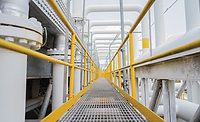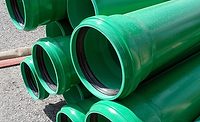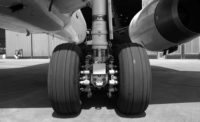Michigan Utility Turns to Unique Coating to Handle Corrosion
New Industrial Coating Offers Long-Term Corrosion Resistance

Faced with extensive corrosion on some heavy equpment, Consumer Energy had two choices, to replace the equipment or to find a way to effectively extend equipment life and reduce operating cost by eliminating the corrosion.

Finding a tough, lasting, easy-to-apply anti-corrosion coating can make the difference between accelerated corrosion that can require pematue replacement, downtime, even shutdown – and equipment and facilities that can safely operate for years and decades.


Left unprotected from water, steam, salt, oxygen and other corrosive elements, structural metals such as steel and aluminum can become rusty, pitted and unusable in critical equipment, buildings and infrastructure. Yet many industrial plants must remain safely, efficiently operational with virtually no downtime, unplanned equipment maintenance or replacement for decades, despite the ravages of corrosion. From tanks, pipes, pumps, turbines, heaters, boilers and compressors to stairs, floors, vehicles and machinery, industrial plants can become virtual rust factories – unless the corrosion is stopped.
Finding a tough, lasting, easy-to-apply anti-corrosion coating can make the difference between accelerated corrosion that requires premature replacement, downtime, even shutdown – and equipment and facilities that safely operate for years and decades.
Consumers Energy, one of the nation’s largest combination utilities, provides electric and natural gas service to nearly 6.5 million Michigan residents in all 68 Lower Peninsula counties. To extend equipment life and reduce operating cost to benefit the public, Consumers Energy sought to reduce equipment corrosion.
“Living in the Snowbelt, the salt and chloride used to keep roads drivable can be very corrosive to metal and shorten the usable life of utility equipment,” says Kyle Jones, Fleet Regulatory and Technical Manager at Consumers Energy. “Vehicle chassis and bodies often see accelerated corrosion.”
While traditional corrosion protection has relied mostly on short-lived physically bonded coverings of substrate surfaces, a growing number of pro-active, environmentally minded companies like Consumers Energy are turning to a new category of tough, chemically bonded phosphate ceramics (CBPCs) that can stop corrosion and extend equipment life.
Industrial facility and equipment managers have typically used polymer-based paints as a physical barrier to keep corrosion promoters such as salt water and oxygen away from steel and aluminum substrates. This works until the paint is scratched, chipped or breached, and corrosion promoters enter the gap between the substrate and polymer-based coating. Then the coating can act like a greenhouse – trapping water, oxygen and other corrosion promoters – allowing corrosion to spread.
Placing sacrificial, reactive elements next to steel that will corrode first, such as zinc and galvanized coatings, is another strategy. This works until the sacrificial elements are used up and recoating must be done, usually after a few years. For assets that demand long-term corrosion protection, stainless steel alloys work. But with stainless steel costing up to six times more than mild steel, this option is often cost prohibitive.
Corrosion Protection
Ideally, engineers, facility managers and industrial paint contractors would want the long-term corrosion resistance offered by stainless steel but at the low cost of a typical coating. A new category of CBPCs such as EonCoat, by a Wilson, NC-based company of the same name, now makes this possible.
Consumers Energy chose EonCoat as a primer to stop the corrosion and extend the life of some of their equipment, saving the cost of replacement. While the ceramic coating was used as a primer, it can stand on its own as a single anti-corrosion coating without the need for a primer or additional topcoats.
“We’re aiming to extend the usable lifespan of our equipment, while lowering O&M and acquisition costs with EonCoat as a corrosion protector,” says Jones. “One goal is to slow or stop the corrosion in vehicle chassis and bodies to match the longer lifespans of our accompanying aerial devices. We’re looking into utility equipment applications ranging from loadbank trailers and steel utility boxes to bucket trucks and derricks. Generating plant applications may also be a future possibility. If we’re more effective and cost-efficient, ultimately our customers benefit.”
In contrast to typical polymer-based coatings that physically adhere to the substrate, the anti-corrosion coating bonds through a chemical reaction with the substrate, and slight surface oxidation actually improves the reaction. This makes it impossible for corrosion promoters like oxygen and humidity to get behind the coating the way they can with ordinary paints. The corrosion barrier is covered by a true ceramic shell, which resists corrosion, fire, water, abrasion, chemicals and temperatures up to 1,000 °F.
Ceramic coatings such as this consist of two non-hazardous ingredients that do not interact until applied by a plural-component spray gun like those commonly used to apply polyurethane foam or polyurea coatings. Since the components are not mixed and do not meet prior to application, the need for hazardous VOC-generating ingredients is completely eliminated, as is odor. This means that the work can get done in occupied areas during business hours.
For Consumers Energy, which has been awarded five Michigan Clean Corporate Citizen awards for exemplary environmental performance, using the ceramic coating has allowed them to maintain their commitment to environmental sustainability. The ceramic coating has no VOCs or HAPs, no hazardous waste for disposal, and 1/10th the carbon footprint of typical coatings.
“When we can cost-effectively do our job in a cleaner, greener manner that shows respect for the environment and the community, that’s what we choose to do,” says Jones.
“Unlike traditional spray coatings that release solvents, with EonCoat there’s no odor and no need for a spray booth or spray mask,” adds Joe Wandron, owner of Ultimate Finish, the Grand Rapids, MI-based paint contractor who did the corrosion protection of the equipment for Consumers Energy.
Wandron used the ceramic coating as a primer for the equipment and applied a standard topcoat for color. According to him, he blast cleaned to a NACE 3, pressure washed off the sand, and coated it in one afternoon.
With the protective ceramic coating, one coat application and minimal prep can give OEM and facility managers significant savings, since the labor is typically cut in half. In contrast to most coatings, the protective ceramic coating does not require labor-intensive surface prep. If the substrate is steel, a commercial blast can deliver a NACE 3 surface so there is no need to sandblast until there is a bright metal surface for the coating to adhere.
“Usually it takes me three days to finish a vehicle: one day to sandblast it, one day to prime it, and one day to paint it,” says Wandron, who has sprayed professionally for 25 years. “With EonCoat, I was able to complete the job in a single day, including the axles, frame and suspension. You’re spraying just one coat for a nice, beautiful surface. It’s dry to the touch in minutes. Unlike traditional paint, there’s no breakdown, set up and clean up between multiple coats because you don’t need multiple coats.”
Since the ceramic coating dries so quickly on exiting the spray nozzle, high-build coatings in one coat are possible. This accelerates equipment maintenance return to service.
“The ceramic coating fills in everything, including uneven surfaces,” adds Wandron. “I could spray as fast as I could walk, and the clean surface allowed me to add a single-color topcoat to finish the job in one day. Clean up took less than five minutes. I just reversed the flow, pumped back what I didn’t use into the buckets, and cleaned it up with a water hose. I didn’t waste any material.”
Another plus for contractors, OEMs and facility managers is how the protective ceramic coating can be applied on hot or cold surfaces from 40 ºF to 150 ºF, which, unlike paint, makes it suitable for all-weather application. “The ceramic coating had no problem spraying in cold Michigan weather,” says Wandron.
“For lasting corrosion protection in everything from cars, trucks, trailers and tractors to boats, buildings, bridges and industrial equipment, I see EonCoat ceramic coating as a game changer,” concludes Wandron. “When it takes hold it doesn’t come loose, and it’s so easy to apply that I believe it will cut painting time in half within a few years.”
For more information, call 252/360.3110, e-mail TonyC@EonCoat.com or visit www.eoncoat.com.
Looking for a reprint of this article?
From high-res PDFs to custom plaques, order your copy today!











